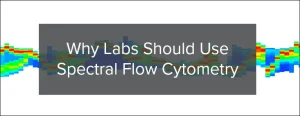July 2, 2024

Flow cytometry has shifted the goalposts of what biomedical research can achieve, enabling widespread, rapid, and reliable assessment of several biomarkers simultaneously using fluorescent signals.
Historically, the implementation of high-dimensional analysis panels has been limited, in part, by the challenges of conventional flow cytometers to distinguish fluorochromes that have similar emission spectra. Furthermore, the spectral overlap between “closely-related” fluorochromes negatively impacts data resolution and subsequently complicates analysis.
By empowering the spectral overlap instead of attempting to eliminate it, spectral flow cytometry has emerged as a powerful alternative to conventional approaches.
But what is spectral flow cytometry, and why should labs embrace it?
What is spectral flow cytometry?
Both conventional and spectral flow cytometry use fluorescently labeled antibodies to detect specific markers or molecules on individual cells.
Unlike conventional, which detects broad overlapping peaks, spectral flow cytometry analyzes the entire spectrum of each fluorochrome used during an assay through spectral unmixing.
Spectral unmixing is the name given to the computerized process that allows the deconvolution of spectral signatures using complex mathematical algorithms to differentiate between fluorophores based on their unique spectral profiles. By leveraging their full-spectrum signatures, spectral flow cytometry can identify and quantify fluorescent signals even if they have substantial overlapping emission spectra, thereby allowing more flexibility in panel design and higher dimensionality of analysis.
Thus, analysts can identify and quantify over 40 fluorochromes simultaneously (compared to less than 30 markers for conventional cytometry ) for more detailed information about cell populations and biomarkers in a single sample.
Spectral flow cytometry can also help improve the resolution and accuracy of measurements whose resolutions are impacted by cellular autofluorescence. Indeed, spectral flow cytometry allows the identification of an autofluorescence signature from unstained samples which can subsequently be subtracted from the total fluorescence of stained samples.
Cytek® is the current market leader in the field of spectral flow cytometry with their Aurora instrument.
Key features of spectral and conventional flow cytometry
| Feature | Spectral Flow Cytometry | Conventional Flow Cytometry |
|---|---|---|
| Detection Method | Full spectrum emission capture | Discrete bandwidth with a single detector per fluorochrome |
| Fluorochrome Overlap Differentiation | Spectral unmixing | Compensation |
| Autofluorescence Handling | Yes, extracted as another color | Limited, through the use of calculation tools |
| Number of Detectable Fluorochromes | 40+ | Up to 30 |
| Flexibility in Fluorophore Selection | High, due to spectral signature analysis | Limited by optical filters |
Practical Applications of Spectral Flow Cytometry
Spectral flow cytometry continues to gain traction within the flow cytometry community, as both instruments and services become increasingly accessible.
Talks at CYTO 2023 highlighted three emerging areas for this approach:
1. Lung analysis
Lung is a very challenging tissue to analyze, owing to cellular complexity and high autofluorescence. Kewal Asosingh, Cleveland Clinic, highlighted how spectral flow cytometry handled autofluorescence and helped identify cellular subsets associated with impaired lung function in asthma.[i]
The study also showed a strong correlation between a decreased lung function and eosinophil — something more commonly thought to be associated with neutrophils.
2. Global clinical trials
Spectral flow cytometry provides detailed insights into immune cell identification, drug kinetics, and biomarker characterization.
Global standardization across laboratories ensuring consistency and high-quality data generation is a current need for this growing market. Standardized workflow achieved by several groups has shown spectral flow cytometry’s utility in global clinical trials[ii], offering deeper immune profiling.
3. High parameter analysis
A combination of an increasing number of dyes and advances in spectral technology opens new avenues for panel development.
As an example, Sandrine Schmutz, Institut Pasteur, reported a panel of 42 fluorescent markers, enabling deep phenotyping of most subsets of hematopoietic cells.[ii]
Deeper Insights into Complex Samples with Spectral Flow Cytometry
Spectral flow cytometry has several advantages over traditional analytical methods, offering a higher number of parameters and autofluorescence handling. Even small panels usually reserved for conventional flow cytometry could see their resolution increased with spectral flow cytometry.
CellCarta offers a broad range of services and biomarker expertise for deeper insights into your studies.
Contact the team to speak to an expert about how to leverage spectral flow cytometry into your clinical programs.
About the author:

Martin Turcotte (PhD) is a Senior Scientist at CellCarta, specializing in cytometry assay development. He led the implementation of the CYTEK Aurora spectral flow cytometry platform at the Montreal site. Martin has over 5 years of experience in development and validation of flow-based assays. He studied biopharmaceutical sciences and obtained a PhD in immuno-oncology.
[i] Asosingh, K. Four-dimensional functional pulmonary imaging in combination with high-dimensional flow cytometry identifies cellular subsets associated with impaired lung function in asthma (talk), CYTO 2023 (2023).
[ii] Schmutz, S. Full Spectrum Spectral Cytometry: evolution & new features for high parameter analysis (talk), CYTO 2023 (2023).
You might also be interested by
CellTalk Blog
B-Cell Populations in Focus: A New Flow Cytometry Assay for Increased Sensitivity in Autoimmune Research
September 19, 2025
Flow Cytometry
More infoCellTalk Blog
Flow Cytometry Applications: Advanced Uses, Benefits, and Limitations
October 17, 2024
Flow Cytometry
More infoCellTalk Blog
How to ensure consistent flow cytometry readouts between labs and optimize your clinical trials
September 18, 2024
Flow Cytometry
More info